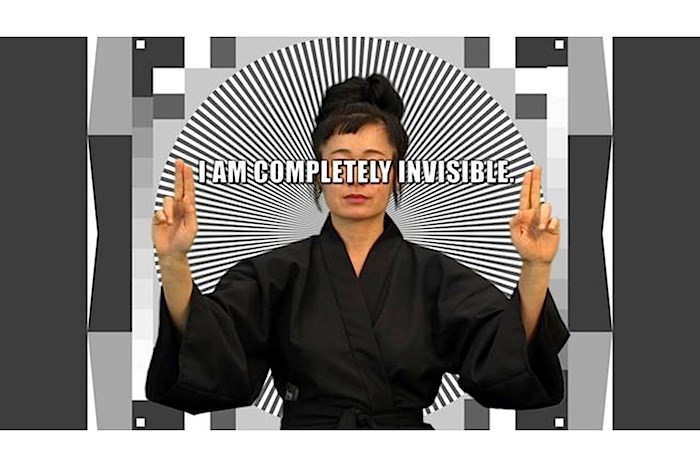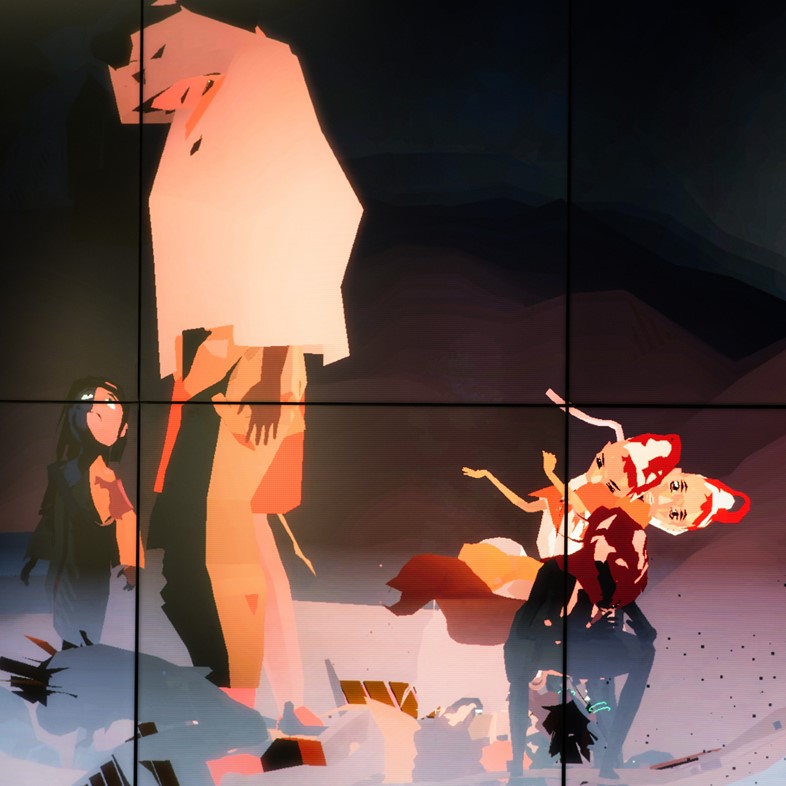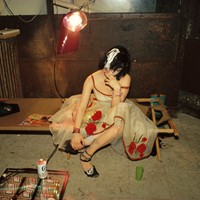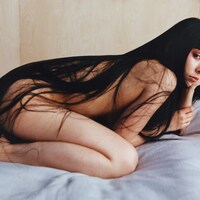For our latest installment of the Age of AI, AI curator Ben Vickers reflects on the artists showing AI can’t move forward without art
Until very recently, I was an AI skeptic. To my mind, our AI future looked something like the horrifying episode of The Simpsons in which the AI house, voiced by Pierce Brosnan, tries to kill Marge – but instead, I envisioned myself on the run from Sophia the Robot. The escalating intensity of technology this year has made me feel like we're headed for robot vs human apocalyptic showdown, much like I, Robot (cue melting robot faces). But I guess what was really bugging me the most was that AI had found its way into art: something I value as an act of pure human emotion and consciousness.
It wasn’t until I met curator and AI art expert, Ben Vickers, that I realised that the question isn’t what AI will to do art – it’s about what art can bring to the evolution of AI. If the way art has revolutionised humankind for the better over time is anything to go by, then perhaps art is actually the only way we can stop the robot apocalypse from becoming real life. For Vickers, who has collaborated with multiple artists on AI projects, and who recently curated Ian Cheng’s innovative AI show at the Serpentine, AI art is a new way for humans to understand our relationship with other non-human entities, like animals and the afterlife.
“One of the most interesting aspects with AI art is that it creates a situation in which we can begin to reconsider our approach to non-human entities” – Ben Vickers
“You have this mainstream narrative of AI being a kind of master-slave dialectic, where it's either this omnipresent god or is somehow in service to you,” explains Vickers. “But a lot of artists are working in this moment to rethink and reframe that narrative, to think about a different relationship to non-human entities. I don't necessarily see this as binary in terms of good or bad, but it does quite unsettle things currently in play. One of the most interesting aspects with AI art is that it creates a situation in which we can begin to reconsider our approach to non-human entities that we're interacting with, which, forces us to rethink our relationship to other non-human entities, such as the entire animal kingdom, other forms of consciousness.”
The easiest way to understand the relationship between AI and art is through three primary functions, where AI acts as either impersonator, collaborator, or creator. As an impersonator, machines are taught to replicate already existing artworks through a unique called style transfer. This is mostly seen with the recreation of classic paintings, such as artist Robbie Barrat, who fed a Generative Adversarial Network (GAN) thousands of nude portraits from across different centuries and strains of art to produce eerily beautiful AI Nudes. As collaborator, AI and artist work together to produce work that is part-robot, part-human production. Artist Mario Klingerman collaborates with AI by going inside neural networks and seeing what photos look like at different coordinates. AI as creator is where things get a little more dangerous. As Vickers states, “AI as collaborator is a better narrative to tell in this moment, because of where the technology is at. But I don't necessarily think it's like the long-term desire to go forward in that way.”
As part of our campaign AGE OF AI, we hear from Vickers on five artists who are defining AI right now and leading us into the future.

IAN CHENG
Ben Vickers: Ian Cheng is definitely the artist that is producing the most advanced work in respect to thinking about human relationships within the field of artificial intelligence. Let’s take, for example, the project BOB, Bag of Beliefs that we produced together at the Serpentine. In this work, he draws on theories such as Ursula Le Guin’s Carrier Bag Theory of Fiction, to rethink the narrative structure of AI. By creating a container for multiple AI inside one single organism, being BOB. Which introduces layers of complexity that are both theoretically narrative-driven and technically sophisticated.
“What is also important in Ian’s work, is that it veers away from the dominant use of AI at the moment, which is machine learning. Ian doesn't work with machine learning to develop the core of his artworks, he works with logic based systems, which people often refer to as a good old-fashioned AI. This work is heavily influenced by a particular AI researcher called Richard Evans at Deepmind as his pioneering work both there and in games such as the Sims. As such Ian’s work is in direct dialogue with advanced AI researchers, which is rare for artistic work of this nature. The work he developed at the Serpentine was perhaps the most advanced example of artificial intelligence shown in a gallery to date.”
LYNN HERSHMAN
Ben Vickers: “Lynn Hershman is an artist who is fundamentally important to recognise in the history of artificial intelligence’s role in the arts, as she was producing artworks a long time before the current craze for AI in art. Developing key works such as Agent Ruby ’s EDream Portal, in 2002. Which mirrored development of AI bots created for the purpose of completing the turing test.
“As somebody who was very, very far ahead of her time, (Hershman) was doing this before anyone else either cared or understood the impact that AI was likely to have. And I think that it is only now that she is being recognised for these significant contributions and the canonical artworks it produced. ”
JENNA SUTELA
Ben Vickers: “Jenna Sutela is a Finnish artist who works with slime mould, artificial lifeform, AI, and theories such as that of panspermia. Panspermia is a theory about how humankind was created, which believes we didn’t come from the Big Bang. It believes that instead, meteors birthed life on earth through the interplanetary transfer of microbial life. Other theories of Panspermia suggest that mushrooms were also brought to earth this way and are therefore among the oldest entities on the planet. Jenna draws from and develops upon these theories and materials in exciting and unexpected ways throughout her work. Particularly in her work Orgs that features the use of slime mould, demonstrating an entirely different and uncanny form of intelligence. Slime mould can root around a maze or a labyrinth and find food, so her work recognises that the mould has this very interesting form of intelligence that people haven’t necessarily assigned to it previously. That’s the work that she's done previously, so she has this relationship with non-human entities.
”More recently, she's been developing work and researching with Google engineers at Somerset House to create what she refers as a bio computer, in which she has essentially been teaching a machine to speak in tongues, or to channel entities that usually cannot speak. To do this, she is utilising machine learning to derive language from Bacilli subtilis, a bacterium, found in soil and the gastrointestinal tract of ruminants and humans. In this deep research practice, Sutela brings ideas to the discussion of artificial intelligence that very few are considering right now. ”
HITO STEYERL
Ben Vickers: “Hito Steyerl is without question one of the most important artists of our time and it's a great privilege that we are currently working together on a show that opens next March at the Serpentine. Steyerl works with different degrees of varying complex technologies primarily through video works and installations. The subject matter of her films ranges from autonomous space programs to the artworlds complicity in the military industrial complex. Her recent work has played a key role in framing the impact of advanced technologies on society.
“In terms of her works relation to AI, in a recent series of talks, Hito focused on artificial stupidity being one of the greatest threats in this moment of time. She discusses an opposition to Silicon Valley’s view on AGI (artificial general intelligence), where a common belief emerges that we are going to be able to create super-advanced intelligences in the future. These beliefs are backed by likes of Nick Bostrom and Elon Musk, who say that we will face an AI apocalypse, and as a result, we are going to have a militarised Terminator-like scenario. Hito says that’s a fairly ridiculous reaction and actually, the real issue we face right now is artificial stupidity, which manifests in bot armies that are able to produce fake news or sway elections. She suggests that this stupid form of AI, that just engages large numbers of people online, really impacts how people think, and that this is a much greater issue than the potential emergence of a single super AI intent on annihilating humankind. And I agree with that.”
JAMES BRIDLE
Ben Vickers: “James Bridle just released his book New Dark Age, which is an essential read on the key subjects around AI, and the dangerous feedback loops that are currently being produced. When we worked with James at the Serpentine, we developed a work called The Cloud Index. To develop the work, we fed a neural net with satellite images of the UK’s weather formations and Brexit polling results that showed the UK's relationship to Europe. What this did was produce a piece of software that can be used to create different weather formations based on different political outcomes. Here, James’ work looks at the history of the cloud, particularly in its early history in relation to the ENIAC computer being used to calculate meteorological result, but also the same computer used to run the mathematics of the atomic bomb. So there has always been a relationship between computers, the weather, the military-industrial complex.
Whilst slightly absurdist in its initial proposition - what James skillfully bought together was the promises of “Big Data” and Silicon Valley’s solutionist approach to the world, with the logical end-point for that thinking. We put forward the notion that ‘If we wish to change the future, we must change the weather.’”




